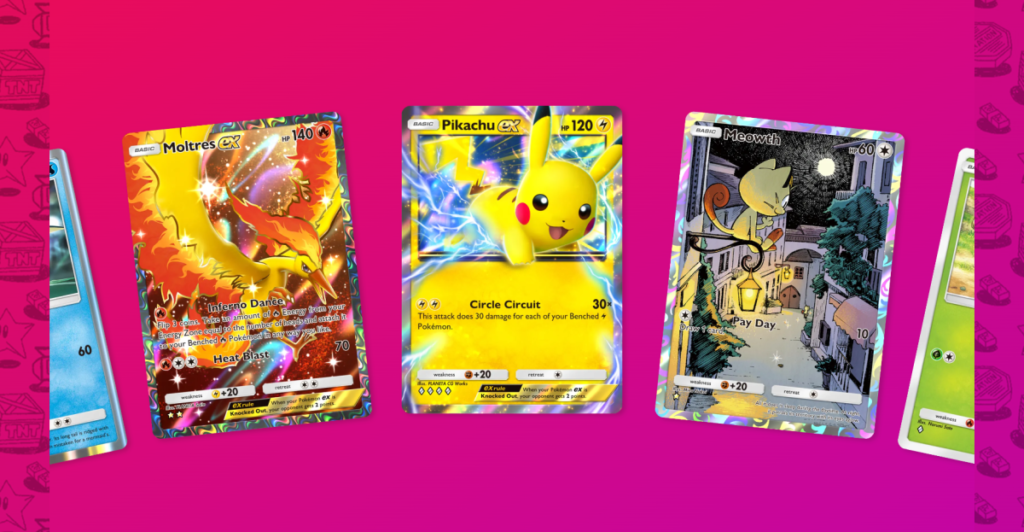The Pokémon TCG Pocket meta must’ve recently turned 30 — because it’s finally settling down!
Released in late 2024, Pokémon TCG Pocket is a card-collecting game with a competitive streak — a streamlined iteration on the classic Pokémon trading card game. There’s incentive to play battles, as winning earns you XP, which helps you level up, which helps you open more booster packs, which helps you build better decks to win more battles. Ah, the great mobile game feedback loop.
What follows is a summary of the Pokémon TCG Pocket meta as of February 2025, including the best decks and the best cards in the wake of the Space-Time Smackdown expansion.
What is the Pokémon TCG Pocket meta right now?

Graphic: Polygon | Source images: Creatures, DeNA/The Pokémon Company
The Jan. 30 release of the Space-Time Smackdown cards introduced a number of wrinkles to Pokémon TCG Pocket. It added a bunch of new ex cards (like Dialga, Palkia, Darkrai, and Weavile). Metal-type and darkness-type decks are good now! Pokémon Tools exist! For the first time in TCG Pocket’s history, there’s some serious variety in how the game is played.
Once upon a time, if you didn’t have the card(s) of the moment, you were done for. That is no longer the case.
At launch, which only featured the Genetic Apex expansion, cards like Mewtwo ex and Charizard ex were dominant. Following the December 2024 release of the Mythical Island expansion, Celebi ex clearly ran the table. Now that there are three expansions out, while there are plenty of powerful new cards to be aware of (Darkrai ex is a popular breakaway), Pokémon TCG Pocket is finally in a place where the meta has some serious variety.
Pokémon TCG Pocket best decks
Knowing the best cards of the moment is one thing, but getting those cards is another matter. Right now, the Pokémon TCG Pocket meta is largely defined by ex cards — high-power cards that are also extremely rare — but a number of a cards that can increase your energy production are also quite popular.
Pretty much every deck that has been dominant to date is still powerful, though you don’t see them around as frequently with the arrival of Space-Time Smackdown. To be clear, they’re good! They’re no less effective — just a bit passé. With that in mind, we’re keeping them on this list of the best decks, and are adding the three newest additions to the top — meaning the eight best decks in Pokémon TCG Pocket as of February 2025 are:
- Darkrai ex (darkness-type)
- Dialga ex (metal-type)
- Lucario (fighting-type)
- Celebi ex (grass-type)
- Charizard ex and Moltres ex (fire-type)
- Articuno ex and Lapras ex (water-type)
- Pikachu ex (electric-type)
- Mewtwo ex and Gardevoir (psychic-type)
Though many dragon Pokémon are rising in viability (like Druddigon and Garchomp), you’ll see that the best decks are still built around a single energy type, to minimize yet another coin flip in battles. We’ll get into detail about why these decks are so successful below. And if you’re on a bad luck streak with opening booster packs, you can also use pack points or trading the get the exact card(s) you’re looking for.
Here are the best decks in Pokémon TCG Pocket, with the key cards for each deck highlighted in bold.

Graphic: Polygon/Ana Diaz | Image sources: Creatures Inc., DeNA/The Pokémon Company via Polygon
Darkrai ex is the stuff of nightmares. As an ex card, its stat line (140 HP and an attack that costs three energy and deals 80 damage) isn’t particularly amazing. But its ability, Nightmare Aura, makes up for the deficit. Every time you attach a darkness energy to Darkrai ex, you’ll automatically deal 20 damage to your opponent’s active Pokémon.
That extra 20 damage is often enough to eliminate an opponent’s active Pokémon when combined with an attack from yours. And if you’re worried about Darkrai ex hogging energy from the rest of your team, you can use the Dawn trainer card, which allows you to move energy from a benched Pokémon to your active Pokémon.
While Darkrai ex has synergy with most popular darkness-type Pokémon (like Weezing, Toxicroak, Arbok, or the Nido evolution chains), the hack here is unconventional: Magnezone, with its powerful 110-damage attack, Thunder Blast. Its earlier-stage evolution, Magneton, has an ability that allows you to add one lightning-type energy to it per turn — regardless of what energy type you’ve set for your deck. The result is one Pokémon that accrues energy all by itself and another Pokémon that consistently deals damage simply by existing.
The addition of Dialga ex to TCG Pocket has singlehandedly turned metal-type decks from laughable to competitive. It has 150 HP. One of its attacks deals 100 damage (albeit at the cost of four energy). But the secret weapon is its Metallic Turbo attack, which only deals 30 damage but allows you to attach two metal-type energy to any Pokémon on your bench.
This immediately lowers the previously prohibitively high energy cost for powerful metal-type cards like Melmetal. But because colorless-type Pokémon can use any type of energy, it’s also helpful. As a result, Dialga ex pairs just as well with Pokémon like Regigigas (whose damage-scaling Raging Hammer attack requires four energy), Wigglytuff ex (whose Sleep Song attack puts active Pokémon to sleep), and Pidgeot ex (whose Scattering Cyclone attack deals more damage based on how full your opponent’s bench is).
With the prevalence of dark-type decks these days, fighting-type decks have emerged as a natural counter. And Lucario is an essential inclusion for fighting-type decks.
Lucario isn’t exactly great on its own merits. It only has 100 HP and its attack, Submarine Blow, only deals 40 damage. But its ability, Fighting Coach, is arguably the strongest support ability in the game right now. When in play, Lucario increases the damage output of your fighting-type cards by 20 — and it stacks, too! If the luck of the draw lands such that you can get two copies of Lucario on your bench, all of your fighting-type cards will deal an additional 40 damage per attack.
So while Lucario isn’t worth building a deck around, it’s absolutely worth slotting into any of your existing fighting-type decks. Machamp ex, for instance, could deal up to 160 damage per attack. Kabutops becomes nigh unstoppable with a 90-damage attack (that also heals 90 HP). Golem, already pretty evil when paired with Brock’s energy-ramping tricks, turns into one of the toughest non-ex cards in the game.

Graphic: Ana Diaz/Polygon | Source images: Creatures Inc., DeNA/The Pokémon Company
Celebi ex has held fast as the strongest grass-type deck in the game. Celebi ex’s attack, Powerful Bloom, costs two energy. For every energy attached to Celebi ex, you flip coin — and for every heads you get, you deal 50 damage. Stack enough energy on Celebi ex and you won’t even need luck on your side to take out literally any Pokémon in the game with a single hit.
There are two cards that help you power up Celebi ex. Lilligant’s (which evolves from Petilil) Leaf Supply attack allows you to attach a bonus grass-type energy to any Pokémon on your bench. Serperior (the third-stage evolution of Snivy) has a passive ability, Jungle Totem, that causes any grass-type energy attached to a grass-type Pokémon to count twice. With both of those cards in play, you can power up your Celebi ex into a monster that can predictably deal 250 damage (or more) per turn.
You’ll also want to have an Erika or two in this deck. Erika, a supporter card, heals 50 HP for any grass-type Pokémon — way more than the 20 HP you’d get from a Potion card. Given Celebi ex’s glass cannon nature, keeping its health full is key.
Charizard ex and Moltres ex deck
Fire-type decks are a natural confirmation to Celebi ex’s terror. And the Charizard ex deck remains TCG Pocket’s strongest fire-type deck.
The Charizard ex deck is contingent on using one Pokémon to generate energy for another. The key here is to open with Moltres ex. With its Inferno Dance attack, you flip three coins, and for every heads you get, you can apply one bonus fire energy to a Pokémon on your bench. You can load up a Charmander or Charmeleon with with up to three energy per turn.
When your Charmeleon is ready to evolve into Charizard ex, it’ll hopefully have enough energy to use Charizard ex’s Crimson Storm attack, which costs four energy and deals 200 damage, but also discards two energy per use. Pull off this combo correctly, and your Charizard ex card should have enough energy to persistently use Crimson Storm. Charizard ex also has 180 HP — enough to survive a hit from some of the most powerful attacks, like Mewtwo ex’s Psydrive.
Articuno ex and Lapras ex deck
Galaxy brain here, but if you want to counter the Celebi ex counter, run a water-type deck. The Articuno ex deck has proven tough to beat, particularly when it includes a card like Lapras ex.
Lapras ex was introduced via Pokémon TCG Pocket’s first battle event, and goes hand-in-hand with Articuno ex. Both cards are basic-stage, so you can play them immediately, and both cards have powerful attacks. Articuno ex’s Blizzard attack deals 80 damage to your opponent’s active Pokémon and 10 damage to any cards on their bench, so you can conceivably knock out any weakened Pokémon on your opponent’s back row. Lapras ex’s attack, Bubble Drain, deals 80 damage to your opponent but heals 20 HP to itself.
Both cards are powerful in a vacuum, but to make the most of this deck, you’ll want to use a Misty trainer card. When you play Misty, you flip a coin repeatedly until you get tails. For however many heads you get, you can attach that amount of water energy to one of your Pokémon. If luck is on your side, you can fully power up Lapras ex or Articuno ex in one turn.
Starmie ex, with its 90-damage attack and free retreat, is a solid card to run in this deck. But the secret weapon is the Mythical Island version of Vaporeon (which evolves from Eevee). Its Wash Out ability allows you to move water-type energy from your benched Pokémon to your active Pokémon.
Gyrados ex, introduced in the Mythical Island expansion, has emerged alongside Articuno and Lapras as another uber-powered water-type ex card. It has 180 HP — one of the highest in the game — and its attack, Rampaging Whirlpool, deals 140 damage — enough to eliminate the vast majority of cards in a single hit — plus removes one energy from a randomly selected card on the board, which could screw up your opponent’s strategy.
Rampaging Whirlpool costs four energy. But as with Articuno ex, you can use Misty or the Mythical Island Vaporeon to stack a Gyarados ex with energy. (If you haven’t drawn Gyarados ex, Magikarp, its basic stage, has an attack that allows you to reteat without spending energy.) Yes, you need several matters of chance to tilt in your direction to line up this strategy. But if you’re able to get a powered-up Gyarados ex on the field in the first few turns, you’re unstoppable.
Electric-type decks are the strongest counters to Articuno ex decks. Right now, the best one is still headlined by Pikachu ex, who might as well be Ash Ketchum’s uncannily super-powered Pikachu.
Pikachu ex isn’t part of an evolution chain, so if you draw it, you’re instantly ready to play it. Its attack, Circle Circuit, also only costs two electric energy and deals 30 damage for every electric-type Pokémon on your bench. Stack all three slots on your bench with electric-type Pokémon, and you’re dealing 90 damage per turn.
Electric-type cards in general tend to have lower retreat costs (Electrode has a free retreat, for instance), allowing you to easily swap out cards as needed, keeping your bench — and Pikachu ex’s attack power — at full capacity. This deck also works well with Zapdos ex or Jolteon as backup attackers; both have attacks that can deal up to 200 or 160 damage respectively.
Mewtwo ex and Gardevoir deck

Graphic: Polygon | Source images: DeNA, Creatures/The Pokémon Company
Mewtwo ex dominated the Pokémon TCG Pocket meta at launch — thanks to its Psydrive attack, which deals 150 damage — and continues to be an imposing and widely used deck. Few Pokémon have 150 HP to survive such a hit, but the attack costs Mewtwo ex four energy to use and further discards two psychic-type energy with each use.
The trick here is to lean on Gardevoir. Gardevoir’s ability, Psy Shadow, allows you to add an extra energy to whatever Pokémon you have in the active spot — and you can use it even with Gardevoir on your bench. This combo allows you to recoup the two energy you burn with each use of Psydrive (one from your turn naturally and one Gardevoir’s ability), essentially guaranteeing 150-damage attacks with no drawbacks.
Best cards to include in any meta deck
Finally, every meta-viable deck right now features at least one copy of each of the following trainer cards:
- Cyrus
- Great Cape
- Leaf
- Professor’s Research
Cyrus is basically a laser-targeted version of Sabrina. Where Sabrina forces your opponent to switch out their active card, Cyrus allows you some control over the choice: You can swap in any Pokémon that’s not at full HP, effectively nullifying attempts your opponent makes at retreating a damaged card. By the same metric, the Great Cape Pokémon Tool is just a stronger version of Potion. Rather than healing 20 HP, it increases your card’s total HP by 20, which in some cases can prevent your Pokémon from getting knocked out in a single hit.
At launch, the X Speed card (which reduces your retreat cost by one energy) was essential for any deck, allowing you to pull a card with low HP back to your bench in a pinch. Leaf is basically a better version of that card: It reduces the retreat cost of your active Pokémon by two for the duration of your turn.
Professor’s Research lets you draw two cards, capitalizing on the universal card game theory that suggests, the more cards you draw, the better your chances of victory. It’s one of the first cards you get, and one of the simplest. Doesn’t mean it’s not, to this day, one of the best.


